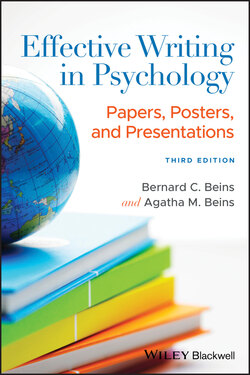Читать книгу Effective Writing in Psychology - Bernard C. Beins - Страница 12
ОглавлениеPreface to the First Edition
Mark Twain recognized the importance of effective writing skills when he said, “The difference between the right word and the nearly right word is the same as that between lightning and the lightning bug.” We wrote this book to help writers generate their own version of lightning when they write papers, create posters, or develop presentations in psychology.
As we have taught courses in writing and in psychology (one of us for over a third of a century), we have become very aware how important it is for students and researchers to develop solid communication skills. No matter what type of professional work you undertake, it will be critical for you to convey your ideas well.
As you write and communicate in psychology, you will face challenges that some other types of writers do not. Writing in psychology involves two separate components. One concerns the ability to create clear and crisp prose that people want to read. The second relates to the ability to convey a compelling message in technical and scientific language. All too often, scientific writers understand their concepts exceedingly well, but they fail to present a message that readers can understand, appreciate, or even want to read. Here this book enters the picture. We present suggestions and guidelines that will help you create interesting papers and cogently delivered oral presentations that will capture the attention of others.
This book will help writers at all levels of experience and skill. Some components of the book are oriented toward effective writing and give tips that are relevant for communicating with many different readerships. Other components provide direction for successful use of writing in APA style. By using both of these aspects of the book, first‐time and experienced writers can be comfortable knowing that their words will have an impact and that their work will be recognized as of professional quality.
We have worked to make this book both accessible and useful. At the same time, we have made it rigorous because writing should be as clear and precise as it is interesting.
Organization of This Book
The book begins with an overview of different kinds of writing and what makes writing for psychology different. In addition, we introduce some of the principles for developing credible arguments and effective communication, whether you are writing, speaking, or creating graphic presentations. We also introduce APA style, which is common in many of the behavioral and social sciences.
The book details guidelines on developing your own ideas and conducting Internet and library research to integrate them with issues that others have already addressed. The next focus of the book involves organizing your thoughts and beginning the process of writing and revising.
Following the chapters on effective communication strategies, we offer guidance on the technical aspects of writing a paper in APA style. In Chapters 10 through 15, you will learn how to use APA style accurately and effectively. If you have not already discovered that APA style involves detail after detail, you will learn it here. But we explain those details in ways that will permit you to follow them as you need to.
We also recognize that not all scientific communication occurs through papers. Consequently, in the last section of this book, we offer strategies for creating poster presentations, giving oral presentations, developing Internet presentations, and writing proposals for institutional review boards.
Finally, we have included a sample APA‐style paper to help you write and format your own work. One of the unique features of the sample paper is that it contains annotated errors that writers frequently make. Seeing a paper that illustrates errors that you might make often helps your writing more than seeing flawless papers. If you don't know that you made a mistake, it is hard to know that you need to correct it.
Features
We provide features in this book that we hope will make the process of writing more effective and efficient. First, we tell you not only what constitutes good writing, but why. As a result, you should be able to generalize the points beyond the specific examples we use. Furthermore, the examples in the book come from published research, which gives you a good sense of how effective writers convey their ideas.
Second, we use many tables and figures that illustrate specific guidance in many areas that pose problems for writers. Rather than simply listing formatting details, we have tried to bring them to life in ways that you will be using them.
Finally, as we noted above, we include examples of the types of errors students and researchers actually make. You can learn from the mistakes of others. The sample paper in the appendix includes stylistic and formatting errors that commonly occur so that you can see what to avoid.
Acknowledgments
A book is the product of its authors, but it also takes its final shape because of the contributions of others. For this book, we have benefited from the help of Linda Beins, a librarian extraordinaire with extensive insights into finding and developing information. We were also fortunate to have the keen eyes and intellect of Stephen F. Davis, Kenneth D. Keith, and Suzanne Baker, who provided us with feedback on early versions of the chapters.
Finally, we are grateful for the consistent help of Chris Cardone, executive editor, and Sarah Coleman, development project manager, two of Wiley‐Blackwell's astute staff who have made this project as seamless as it could have possibly been.
